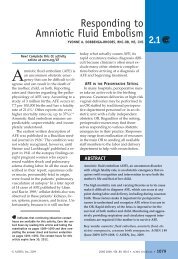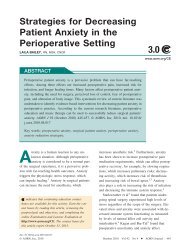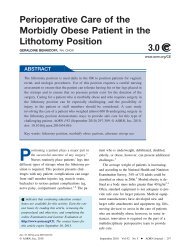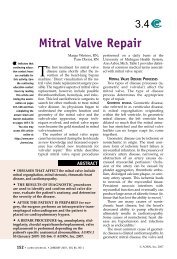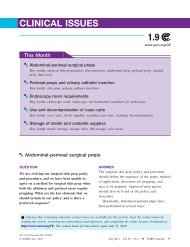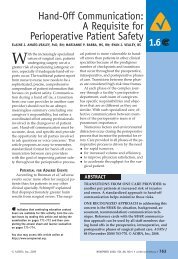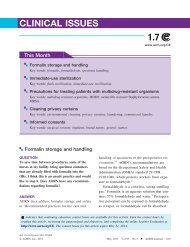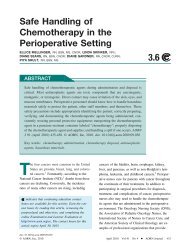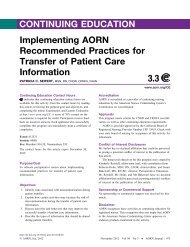Perioperative Care of the Patient with Bipolar Disorder ... - AORN
Perioperative Care of the Patient with Bipolar Disorder ... - AORN
Perioperative Care of the Patient with Bipolar Disorder ... - AORN
Create successful ePaper yourself
Turn your PDF publications into a flip-book with our unique Google optimized e-Paper software.
August 2010 Vol 92 No 2 SAUNDERS<br />
Online Resources*<br />
Depression and <strong>Bipolar</strong> Support Alliance<br />
http://www.dbsalliance.org<br />
National Alliance on Mental Illness<br />
http://www.nami.org<br />
National Institute <strong>of</strong> Mental Health<br />
http://www.nimh.nih.gov/health/topics/<br />
bipolar-disorder/index.shtml<br />
Mental Health America<br />
http://www.mentalhealthamerica.net/go/<br />
information/get-info/bipolar-disorder<br />
*Access verified April 29, 2010<br />
to run in families, <strong>the</strong>re is a strong genetic component;<br />
<strong>the</strong>refore, scientists continue to study this<br />
disorder to locate <strong>the</strong> genes that cause bipolar<br />
disorder. Significantly high or low levels <strong>of</strong> neurotransmitters,<br />
specifically epinephrine, norepinephrine,<br />
dopamine, and serotonin, have been<br />
associated <strong>with</strong> both mania and depression. It is<br />
likely that many different genes combined <strong>with</strong> a<br />
person’s environmental and neurobiological factors<br />
may interact to cause <strong>the</strong> disorder.<br />
SYMPTOMS<br />
Unlike <strong>the</strong> normal ups and downs that everybody<br />
experiences in life, <strong>the</strong> symptoms <strong>of</strong> bipolar disorder<br />
are severe and can be described as unusually<br />
intense emotional states, called “mood episodes.”<br />
6 An overly joyful or overexcited mood<br />
that seems out <strong>of</strong> proportion or inappropriate to<br />
<strong>the</strong> circumstance is called a manic episode. Mania<br />
may present as anger, belligerence, and irritability<br />
instead <strong>of</strong> elation and euphoria in some individuals.<br />
The characteristic symptoms <strong>of</strong> a manic episode<br />
are<br />
� lability (eg, changing quickly from happiness<br />
to anger or depression);<br />
� inappropriate demanding <strong>of</strong> o<strong>the</strong>r’s attention;<br />
� manipulative, pr<strong>of</strong>ane, or sexually explicit language<br />
or behavior;<br />
� grossly inappropriate or loud, rapid speech;<br />
212 <strong>AORN</strong> Journal<br />
� stringing words toge<strong>the</strong>r that rhyme (ie, clang<br />
associations);<br />
� thoughts that race from topic to topic (ie,<br />
flight <strong>of</strong> ideas);<br />
� disorganized thoughts;<br />
� grandiosity (eg, believing oneself to be a<br />
prominent businessman or religious figure);<br />
� restlessness;<br />
� disorganized or aggressive behavior;<br />
� poor concentration and distractibility;<br />
� poor judgment;<br />
� psychomotor agitation; and<br />
� disorientation, incoherence, delusions, and<br />
hallucinations. 3<br />
An extremely sad or hopeless mood is called a<br />
depressive episode. Sometimes, a mood episode<br />
includes symptoms <strong>of</strong> both mania and depression;<br />
this is called a mixed episode. Extreme changes<br />
in activity, behavior, energy, and sleep accompany<br />
<strong>the</strong>se changes in mood. An individual may<br />
be diagnosed <strong>with</strong> bipolar disorder if he or she<br />
has a number <strong>of</strong> manic or depressive symptoms<br />
for most <strong>of</strong> <strong>the</strong> day, nearly every day, for at least<br />
one to two weeks. 1 Sometimes symptoms are so<br />
severe that <strong>the</strong> individual cannot function normally<br />
at work, school, or home.<br />
TREATMENT: MOOD STABILIZERS<br />
Individuals <strong>with</strong> bipolar disorder <strong>of</strong>ten need several<br />
medications. Anti-anxiety, antidepressant, and<br />
atypical antipsychotic medications may be used in<br />
addition to mood stabilizers, which are considered<br />
lifetime maintenance <strong>the</strong>rapy for individuals <strong>with</strong><br />
bipolar disorder. 7 Most <strong>of</strong>ten, lithium carbonate is<br />
<strong>the</strong> first choice <strong>of</strong> mood stabilizer for <strong>the</strong> acute<br />
treatment <strong>of</strong> mania and <strong>the</strong> prevention <strong>of</strong> recurrent<br />
manic episodes. To avoid toxicity, lithium<br />
maintenance blood levels should range between<br />
0.4 mEq/L and 1.3 mEq/L, and not exceed 1.5<br />
mEq/L. 3 Lithium is usually contraindicated in<br />
individuals <strong>with</strong> cardiovascular, renal, or thyroid<br />
disease, or myas<strong>the</strong>nia gravis; those who are<br />
pregnant or breastfeeding; and children younger<br />
than 12 years.



